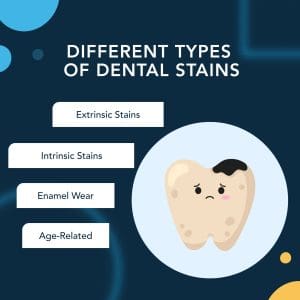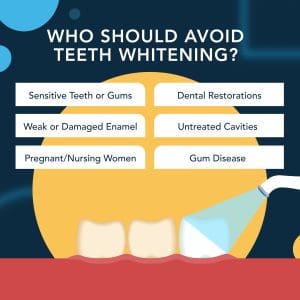A bright, white smile is a common goal, but with so many teeth-whitening options available, it can be difficult to know what truly works. From professional treatments to at-home whitening kits, whitening toothpaste, and even natural remedies, some methods deliver real results while others fall short, or even cause damage. In this article, we’ll break down which whitening methods are effective, which to avoid, and how to safely achieve a whiter, healthier smile.
How Does Teeth Whitening Work?
Teeth whitening works by breaking down stains on the tooth enamel using whitening agents like hydrogen peroxide or carbamide peroxide. These bleaching agents penetrate the enamel to lighten intrinsic stains, while abrasive ingredients in whitening toothpaste help remove extrinsic stains from the surface. The effectiveness of a whitening method depends on the type of discoloration, the concentration of whitening agents, and whether the treatment is professional or at home.
What Causes Tooth Discoloration?
Tooth discoloration can happen for many reasons, from everyday habits to natural changes over time. Certain foods, drinks, and lifestyle choices can gradually dull the brightness of your smile, while internal factors may also play a role. Understanding what causes teeth to lose their whiteness is the first step in choosing the right whitening treatment to restore a brighter, healthier appearance.
Different Types of Dental Stains
Not all tooth discoloration is the same, and different types of stains require different whitening approaches. Stains can occur on the surface of the enamel or deeper within the tooth structure, and some develop gradually over time due to natural aging. Understanding whether stains are extrinsic, intrinsic, or age-related can help determine the most effective teeth whitening treatment for long-lasting results.
Extrinsic Stains (Surface Stains)
Extrinsic stains form on the outer layer of the tooth enamel, usually caused by coffee, tea, red wine, tobacco, and certain foods. These stains build up over time but can often be removed with whitening toothpaste, professional cleanings, or at-home whitening treatments. Since they don’t penetrate deep into the tooth, extrinsic stains are generally easier to treat than other types of discoloration.
Intrinsic Stains (Deeper Stains)
Intrinsic stains occur within the tooth structure, making them more difficult to remove. These stains can be caused by aging, excessive fluoride exposure, certain medications, or trauma to the tooth. Since they don’t respond well to surface whitening treatments, professional teeth whitening procedures, such as bleaching agents or veneers, may be needed to improve their appearance.
Age-Related Staining and Enamel Wear
As we age, tooth enamel naturally wears down, making the underlying dentin more visible. This can cause teeth to appear yellow or dull over time. Additionally, years of consuming stain-causing foods and drinks can compound discoloration. While regular teeth whitening treatments can help, addressing enamel wear with good oral hygiene and professional dental care is essential for maintaining a bright, healthy smile.
Safe, Teeth Whitening Treatments That Work
With so many teeth whitening options available, it’s important to choose methods that are both effective and safe. While some treatments can deliver noticeable results, others may cause tooth sensitivity or even damage tooth enamel if not used properly. Below are the most reliable whitening treatments, ranging from professional procedures to at-home options that help brighten your smile while protecting your oral health.
Professional Teeth Whitening Treatments
Professional whitening treatments performed by a Davie dentist offer the fastest and most effective results. These treatments use high-concentration bleaching agents, often combined with light or laser technology, to break down stains and whiten teeth by several shades in a single visit. Because they are supervised by a dental professional, the risk of tooth sensitivity or enamel damage is minimized, making them a safe and long-lasting whitening solution.
At-Home Whitening Kits and Strips
For those looking for a more convenient and affordable option, at-home whitening kits and whitening strips provide noticeable results over time. These products use lower concentrations of hydrogen peroxide or carbamide peroxide to gradually remove stains. While they are generally safe when used as directed, overuse can lead to tooth sensitivity. Custom whitening trays from a dentist in Broward County can also be a safer and more effective alternative to store-bought kits.
Whitening Toothpaste and Mouthwashes
Whitening toothpaste and mouthwashes offer a mild approach to stain removal. These products contain abrasive agents or small amounts of peroxide to help lift surface stains over time. While they won’t dramatically change the color of your teeth, they can be useful for maintaining results after a professional whitening treatment. For best results, look for dentist-recommended products that protect tooth enamel while gently removing stains.
Teeth Whitening Methods That Don’t Work (or May Cause Harm)
Not all teeth whitening methods are effective or safe. While some DIY and natural remedies claim to brighten teeth, many either provide minimal results or pose risks like enamel damage and tooth sensitivity. Understanding which treatments to avoid can help protect your oral health while ensuring you achieve real whitening results. Below are some common methods that may not be as effective as they seem.
Natural Remedies Like Baking Soda and Charcoal
Many people turn to baking soda or activated charcoal as natural alternatives for teeth whitening, but these methods come with risks. While baking soda can remove surface stains, it is abrasive and may wear down tooth enamel over time. Similarly, charcoal-based toothpaste can be too harsh, leading to weakened enamel and increased tooth sensitivity. These remedies may offer temporary brightness but are not a safe long-term solution.
DIY Hydrogen Peroxide Treatments
Since hydrogen peroxide is a common ingredient in professional whitening treatments, some people attempt to use it at home in stronger concentrations. However, applying undiluted peroxide directly to teeth or mixing it with other ingredients can cause gum irritation, enamel erosion, and tooth sensitivity. Store-bought whitening kits contain carefully measured amounts of peroxide, making them a safer alternative to DIY applications.
Oil Pulling and Other Myths
Oil pulling, which involves swishing coconut or sesame oil in the mouth, is often claimed to remove dental stains and improve oral health. While this practice may have some antibacterial benefits, there is no scientific evidence that it effectively whitens teeth. Other myths, like rubbing fruit peels on teeth or using lemon juice, can actually damage tooth enamel due to their acidity. Sticking to proven whitening methods is the best way to achieve a brighter smile.
Who Should Avoid Teeth Whitening?
While teeth whitening is safe for many people, it’s not the best option for everyone. Certain dental conditions or health concerns can make whitening treatments less effective or even cause discomfort and enamel damage. If you fall into any of the following categories, it’s best to consult with a dentist before starting any whitening treatment to avoid potential risks.
 People with Sensitive Teeth or Gums
People with Sensitive Teeth or Gums
If you already experience tooth sensitivity or gum discomfort, whitening treatments can make it worse. Bleaching agents in whitening products can temporarily weaken tooth enamel, leading to increased sensitivity to hot and cold foods. Those prone to sensitivity should opt for gentle whitening solutions recommended by a dentist or avoid whitening altogether.
Those with Weak or Damaged Enamel
Tooth enamel protects the inner layers of your teeth, and if it’s already thin or weakened, whitening can cause further damage. People with enamel erosion (caused by acidic foods, grinding, or genetics) may experience pain or uneven whitening results. It’s best to find a dentist near me who can evaluate whether your enamel is strong enough for safe whitening or suggest alternative cosmetic treatments.
Individuals with Dental Restorations
If you have crowns, veneers, fillings, or dental bonding, whitening treatments won’t change their color. Since bleaching agents only work on natural tooth enamel, using whitening products may result in an uneven smile, with natural teeth lightening while restorations stay the same shade. A dentist can recommend options to blend the color of restorations with your natural teeth.
Pregnant or Nursing Women
Although teeth whitening isn’t proven to be harmful during pregnancy or breastfeeding, many dentists recommend avoiding it as a precaution. Bleaching agents can cause temporary gum irritation, and increased tooth sensitivity during pregnancy can make whitening uncomfortable. For those expecting or nursing, it’s best to wait until a later time or consult a dentist for safe alternatives.
People with Untreated Cavities or Gum Disease
Before whitening, it’s essential to have a healthy mouth. Cavities, gum disease, and exposed tooth roots can make whitening painful and even worsen oral health problems. Whitening solutions can seep into weakened teeth, causing irritation or damage. Addressing existing dental issues with a dentist first ensures a safer and more effective whitening experience.
How Long Do Teeth Whitening Results Last?
The longevity of teeth whitening results depends on the method used and lifestyle habits. Professional whitening can last six months to three years, while at-home whitening kits typically provide results for a few months. Factors like diet, smoking, and oral hygiene can impact how long teeth stay white. Regular brushing, flossing, and avoiding stain-causing foods and drinks can help maintain a brighter smile for longer.
Schedule Your Next Dental Checkup Today
Achieving a brighter smile takes more than just choosing the right whitening treatment— it requires proper care to maintain your results. Whether you opt for professional whitening from a dentist in Davie, Florida, or at-home treatments, following good oral hygiene habits, avoiding stain-causing foods, and using the right products will help keep your teeth white and healthy. Understanding what works and what doesn’t ensures you get the best, safest results. Are you ready to enhance your smile? Contact us to schedule a consultation, explore your teeth whitening options, and take the next step toward a radiant, confident smile!
April 18, 2025

 Adult
Adult




 People with Sensitive Teeth or Gums
People with Sensitive Teeth or Gums